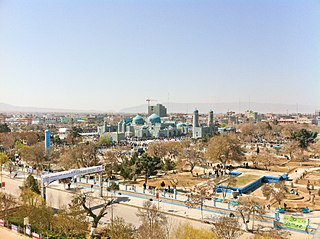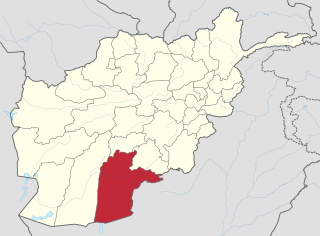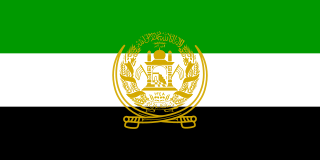
Mazar-i-Sharīf, also known as Mazar-e Sharīf or simply Mazar, is the fourth-largest city in Afghanistan by population, with an estimated 500,207 residents in 2021. It is the capital of Balkh province and is linked by highways with Kunduz in the east, Kabul in the southeast, Herat in the southwest and Termez, Uzbekistan in the north. It is about 55 km (34 mi) from the Uzbek border. The city is also a tourist attraction because of its famous shrines as well as the Islamic and Hellenistic archeological sites. The ancient city of Balkh is also nearby.

The International Security Assistance Force (ISAF) was a multinational military mission in Afghanistan from 2001 to 2014. It was established by United Nations Security Council Resolution 1386 pursuant to the Bonn Agreement, which outlined the establishment of a permanent Afghan government following the U.S. invasion in October 2001. ISAF's primary goal was to train the Afghan National Security Forces (ANSF) and assist Afghanistan in rebuilding key government institutions; it gradually took part in the broader war in Afghanistan against the Taliban insurgency.

Kandahār is one of the thirty-four provinces of Afghanistan, located in the southern part of the country, sharing a border with Pakistan, to the south. It is surrounded by Helmand in the west, Uruzgan in the north and Zabul Province in the east. Its capital is the city of Kandahar, Afghanistan's second largest city, which is located on the Arghandab River. The greater region surrounding the province is called Loy Kandahar. The Emir of Afghanistan sends orders to Kabul from Kandahar making it the de facto capital of Afghanistan, although the main government body operates in Kabul. All meetings with the Emir take place in Kandahar, meetings excluding the Emir are in Kabul.

Kapisa is the smallest province of the Greater Parwan region and the smallest of Afghanistan's thirty-four provinces and is located in the north-east of the country. It has an estimated population of 496,840 people and an area of 1,842 km2 (711 sq mi), making it the most densely populated province apart after Kabul Province. It borders Panjshir Province to the north, Laghman Province to the east, Kabul Province to the south and Parwan Province to the west. Mahmud-i-Raqi is the provincial capital, while the most populous city and district of Kapisa is Nijrab.

Uruzgan, also spelled as Urozgan or Oruzgan, is one of the thirty-four provinces of Afghanistan. Uruzgan is located in the center of the country. The population is 436,079, and the province is mostly a tribal society. Tarinkot serves as the capital of the province.

Sar-e Pol, also spelled Sari Pul, is one of the thirty-four provinces of Afghanistan, located in the north of the country. It borders Ghor and Bamyan to the south, Samangan to the east, Balkh and Jowzjan to the north, and Faryab to the west. The province is divided into 7 districts and contains 896 villages. It has a population of about 632,000, which is multi-ethnic and mostly a tribal society. The province was created in 1988, with the support of northern Afghan politician Sayed Nasim Mihanparast. The city of Sar-e Pol serves as the provincial capital.

The Northern Alliance, officially known as the United Islamic National Front for the Salvation of Afghanistan, was a military alliance of groups that operated between late 1996 to 2001 after the Islamic Emirate of Afghanistan (Taliban) took over Kabul. The United Front was originally assembled by key leaders of the Islamic State of Afghanistan, particularly president Burhanuddin Rabbani and former Defense Minister Ahmad Shah Massoud. Initially it included mostly Tajiks but by 2000, leaders of other ethnic groups had joined the Northern Alliance. This included Karim Khalili, Abdul Rashid Dostum, Abdullah Abdullah, Mohammad Mohaqiq, Abdul Qadir, Asif Mohseni, Amrullah Saleh and others.

Khwahan /(Tajik: Хоҳон) is a town and the capital of Khwahan District, in Badakhshan Province in north-eastern Afghanistan. It is located on the left bank of the Panj River, subregions of Darwaz.

Muqur District is a district located within Badghis Province in the western part of Afghanistan. It is located between the districts of Ab Kamari to the east, Qala i Naw to the south, Qadis to the southeast and Bala Murghab to the northeast. To the north is the national border with Turkmenistan. The district is in a long river valley. The estimated population in 2019 was 26,375.

Mazar-e-Sharif International Airport, officially called Mawlana Jalaluddin Mohammad Balkhi International Airport, is located about 9 km (5.6 mi) east of Mazar-i-Sharif in northern Afghanistan, which is around 15 minutes of driving distance from the center of the city.

Afghanistan has three railway lines in the north of the country. The first is between Mazar-i-Sharif and the border town of Hairatan in Balkh province, which then connects with Uzbek Railways of Uzbekistan. The second links Torghundi in Herat province with Turkmen Railways of Turkmenistan. The third is between Turkmenistan and Aqina in Faryab province of Afghanistan, which extends south to the city of Andkhoy. The country currently lacks a passenger rail service, but a new rail link from Herat to Khaf in Iran for both cargo and passengers was recently completed. Passenger service is also proposed in Hairatan – Mazar-i-Sharif section and Mazar-i-Sharif – Aqina section.
Chasnud-e Payan is a village in Badakhshan Province in north-eastern Afghanistan, located at the confluence of the Chashnud Dara and the Panj River.
Duraj دوراج is a village in Badakhshan Province in north-eastern Afghanistan. It is located on the Darr-i-Kuf Ab River, in the vicinity of the Safid Khers mountains.
Farghamiru is a village in Badakhshan Province in north-eastern Afghanistan., south of Jurm on the Kokcha River.=
Fotur is a village on the left bank of the Ab-i-Panj river in Badakhshan Province in north-eastern Afghanistan.
Ḥazrat-e Saʽid is a village in Badakhshan Province in north-eastern Afghanistan. It is located on the Kokcha River and is on the road to Jurm, about ten miles north of Garghamu.

Jamarch-e Bala is a village in the north-eastern Badakhshan Province of Afghanistan, serving as the capital of Maimay District. It is located on the Panj River near the Vanj River.
Kharat is a village in Badakhshan Province in north-eastern Afghanistan. It is located about 28 miles southeast of Kala Panja.
Khash Darreh is the name of two villages in Badakhshan Province in north-eastern Afghanistan.

Operation Karez was a military operation between May 13–23, 2008 involving Norwegian and German ISAF and Afghan government forces against the Taliban as part of the war in Afghanistan. Their objective was to eliminate the presence of Taliban insurgents who had regrouped in the area in the aftermath of Operation Harekate Yolo in late 2007.














